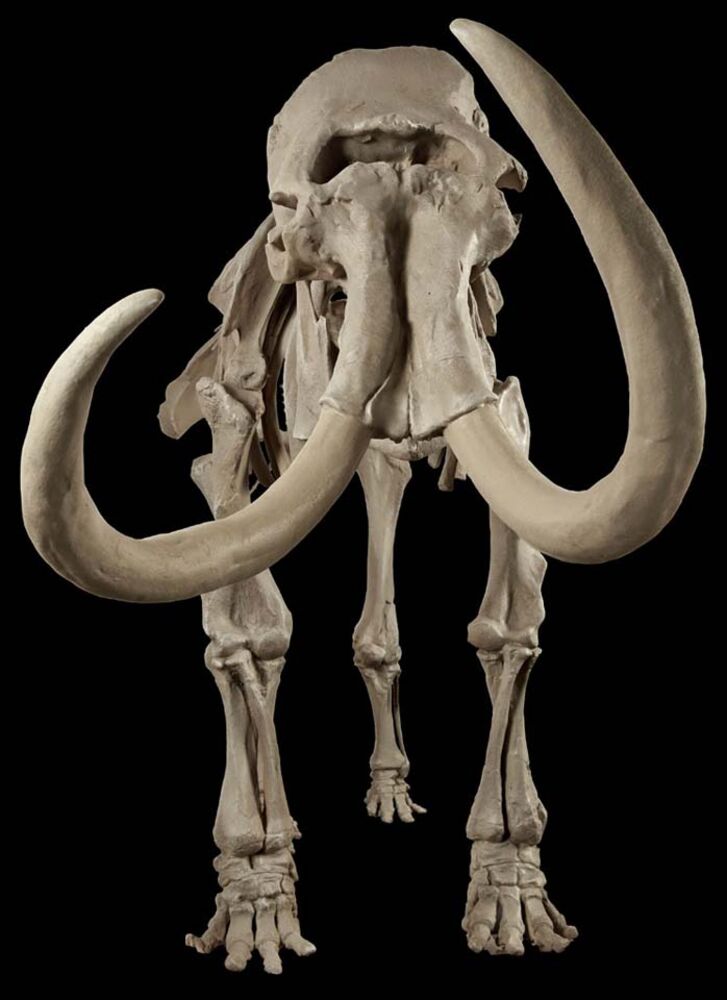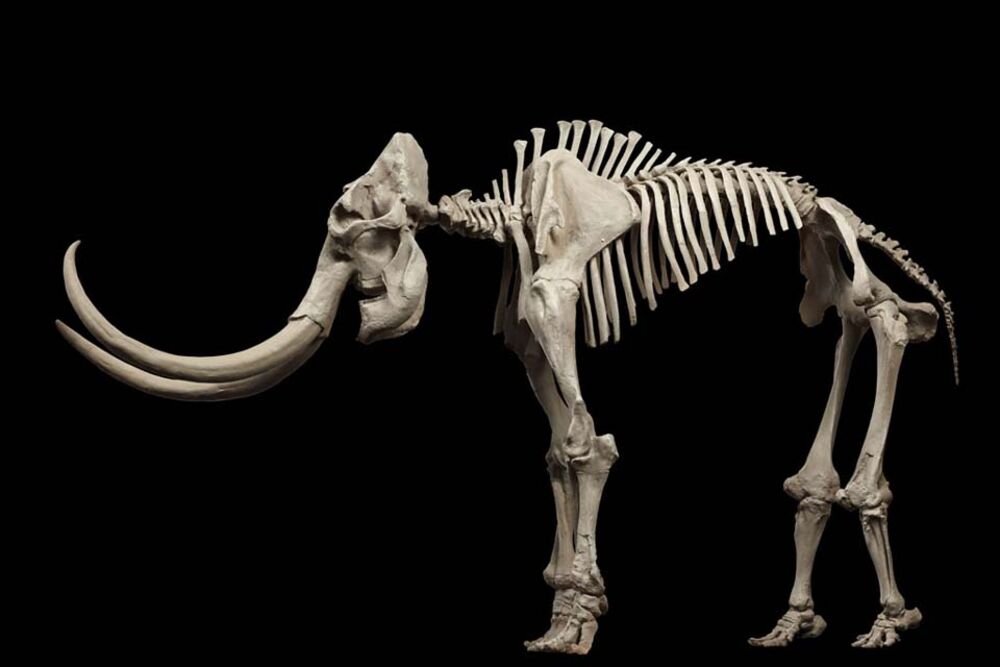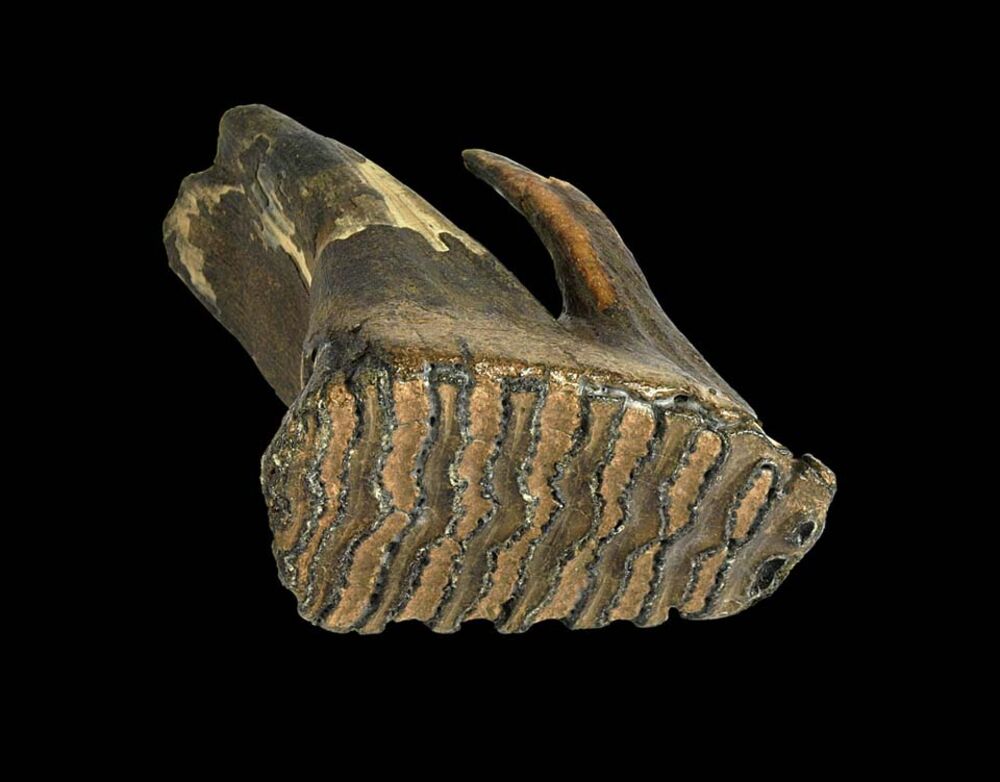14 Mammoth Bones
Surely, the most impressive mammal of the last Ice Age was the woolly mammoth. Bones, molars and tusk fragments keep emerging during gravel mining operations along the Elbe. They indicate that mammoths were quite common in our region. They may have spent the short Ice Age summers in northern Germany, where the lush grassland served as pasture, then migrated southward in the autumns, where they may have weathered the hard winters in a little more temperate areas.
Mammoths lived in large parts of Europe, Asia, Africa, and North America. They were exclusively herbivorous; their diet consisted entirely of grasses and bushes. They reached heights of up to three meters and thus stood about as tall as present-day African elephants, which are also their closest living relatives.
Info: Showcase 14
Tusk
Age: 135.000 - 11.000 v. Chr. Palaeolithic period
Palaeolithic period: Even before temperatures rose noticeably at the end of the last ice age, the first reindeer hunters roamed the North German Plain. The open steppe landscape of this time offered a rich supply of huntable game, including reindeer and other steppe animals such as the wild horse. The spear sling served as an important hunting weapon, giving the spear greater range and penetrating power with the leverage used by the thrower. With a warming of the climate and the disappearance of reindeer from Central and Western Europe, the most recent period of the Paleolithic Age ended 10,000 years ago.
Material: Ivory (Mammoth)
Location: Elbe near Hamburg

Molar Teeth
Age: 135.000 - 11.000 v. Chr. Palaeolithic period
Palaeolithic period: Even before temperatures rose noticeably at the end of the last ice age, the first reindeer hunters roamed the North German Plain. The open steppe landscape of this time offered a rich supply of huntable game, including reindeer and other steppe animals such as the wild horse. The spear sling served as an important hunting weapon, giving the spear greater range and penetrating power with the leverage used by the thrower. With a warming of the climate and the disappearance of reindeer from Central and Western Europe, the most recent period of the Paleolithic Age ended 10,000 years ago.
Material: Animal Bone (Mammoth)
Location: Elbe near Hamburg
Rib
Age: 135.000 - 11.000 v. Chr. Palaeolithic period
Palaeolithic period: Even before temperatures rose noticeably at the end of the last ice age, the first reindeer hunters roamed the North German Plain. The open steppe landscape of this time offered a rich supply of huntable game, including reindeer and other steppe animals such as the wild horse. The spear sling served as an important hunting weapon, giving the spear greater range and penetrating power with the leverage used by the thrower. With a warming of the climate and the disappearance of reindeer from Central and Western Europe, the most recent period of the Paleolithic Age ended 10,000 years ago.
Material: Animal Bone (Mammoth)
Location: Elbe near Hamburg
Vertebrae
Age: 135.000 - 11.000 v. Chr. Palaeolithic period
Palaeolithic period: Even before temperatures rose noticeably at the end of the last ice age, the first reindeer hunters roamed the North German Plain. The open steppe landscape of this time offered a rich supply of huntable game, including reindeer and other steppe animals such as the wild horse. The spear sling served as an important hunting weapon, giving the spear greater range and penetrating power with the leverage used by the thrower. With a warming of the climate and the disappearance of reindeer from Central and Western Europe, the most recent period of the Paleolithic Age ended 10,000 years ago.
Material: Animal Bone (Mammoth)
Location: Elbe near Hamburg
Pelvis
Age: 135.000 - 11.000 v. Chr. Palaeolithic period
Palaeolithic period: Even before temperatures rose noticeably at the end of the last ice age, the first reindeer hunters roamed the North German Plain. The open steppe landscape of this time offered a rich supply of huntable game, including reindeer and other steppe animals such as the wild horse. The spear sling served as an important hunting weapon, giving the spear greater range and penetrating power with the leverage used by the thrower. With a warming of the climate and the disappearance of reindeer from Central and Western Europe, the most recent period of the Paleolithic Age ended 10,000 years ago.
Material: Animal Bone (Mammoth)
Location: Elbe near Hamburg
Humeral Bone
Age: 135.000 - 11.000 v. Chr. Palaeolithic period
Palaeolithic period: Even before temperatures rose noticeably at the end of the last ice age, the first reindeer hunters roamed the North German Plain. The open steppe landscape of this time offered a rich supply of huntable game, including reindeer and other steppe animals such as the wild horse. The spear sling served as an important hunting weapon, giving the spear greater range and penetrating power with the leverage used by the thrower. With a warming of the climate and the disappearance of reindeer from Central and Western Europe, the most recent period of the Paleolithic Age ended 10,000 years ago.
Material: Animal Bone (Mammoth)
Location: Elbe near Hamburg



